With 90% of CEOs in S&P 500 companies still being promoted or hired from line roles — only 20% of women in senior VP positions hold line roles — narrowing the gender gap in the C-suite will take upward of 100 years based on current trends, per research by McKinsey Global Institute.
Unfortunately, study after study reveals that there is little to no optimism that the trend tide will change — fewer than 50% of employees, per McKinsey, believe 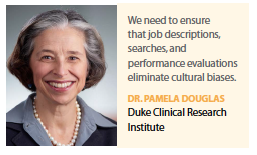 their company is doing what it takes to improve gender diversity. Within the healthcare ecosystem particularly, analysts at Rock Health say about 55% of respondents believe it will take 25-plus years to achieve gender parity in the workplace, up from 45% in 2017. Just 5% say it will happen in the next five years. Women who took the 2018 survey continue to be pessimistic about how long it will take to reach parity, although this year, fewer say parity will never happen.
their company is doing what it takes to improve gender diversity. Within the healthcare ecosystem particularly, analysts at Rock Health say about 55% of respondents believe it will take 25-plus years to achieve gender parity in the workplace, up from 45% in 2017. Just 5% say it will happen in the next five years. Women who took the 2018 survey continue to be pessimistic about how long it will take to reach parity, although this year, fewer say parity will never happen.
Authors of the Rock Health study hypothesize that perhaps the pessimism comes from the sluggish pace of change. They note that the percentage of women on Fortune 500 healthcare executive teams and boards has been nearly flat since 2015, hovering around 22%. Women in the startup world have also seen little change: the percentage of women CEOs of funded digital health startups, as well as the percentage of women VC partners, stands around 10% to 12%.
Gender Parity is a Business Issue, Not a Women’s Issue
The authors of the 2018 Rock Health Study — Halle Tecco, founder emeritus, and Michelle Huang, research fellow — state when women are treated as inferior 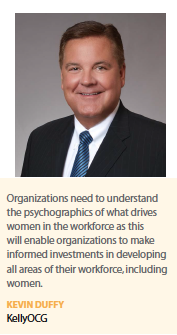 to men in the workplace, they face challenges ranging from wage discrimination to stunted career advancement to harassment. While the overt actions that plagued the Mad Men generation are slowly being chipped away, they say women still face covert discrimination that’s harder to identify and resolve. “Gender discrimination — in any of its ugly forms — is not just unjust, it’s bad for business," Ms. Huang says.
to men in the workplace, they face challenges ranging from wage discrimination to stunted career advancement to harassment. While the overt actions that plagued the Mad Men generation are slowly being chipped away, they say women still face covert discrimination that’s harder to identify and resolve. “Gender discrimination — in any of its ugly forms — is not just unjust, it’s bad for business," Ms. Huang says.
According to McKinsey, if countries, companies, and communities accelerated progress there is a $12 trillion gender parity opportunity in the next decade to be realized. To cite another recent McKinsey study, gender parity on executive teams correlates with both short-term profitability and long-term value creation.
“There isn’t sufficient publication real estate to adequately capture the incredibly strong business case for investing in women leaders in our workforce," says Laurie Cooke, CEO, Healthcare Businesswomen’s Association. The HBA’s mission is to achieve gender parity in leadership positions, facilitate career and business connections, and provide effective practices that enable organizations to realize the full potential of their female talent, all toward the core purpose to further the advancement and impact of women in the business of healthcare.
“There are a plethora of benefits supported by an equally robust archive of data that validate the measurable return a company will realize by ensuring gender parity is achieved in top leadership teams and throughout the organization," Ms. Cooke says.
“My top five are: improved financial results, enhanced team collaboration and 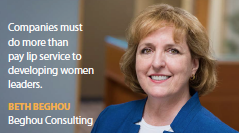 productivity, increased innovation, greater employee retention, and better understanding of customer and markets. In short, gender parity is not a women’s issue; it is a business opportunity."
productivity, increased innovation, greater employee retention, and better understanding of customer and markets. In short, gender parity is not a women’s issue; it is a business opportunity."
According to Forbes, only 5.6% of the Fortune 1000 companies have female CEOs, yet according to the Department of Labor, 47% of the U.S. workforce are women. “To that end, organizations need to understand the psychographics of what drives women in the workforce as this will enable organizations to make informed investments in developing all areas of their workforce, including women," says Kevin Duffy, global OVP, life science and healthcare vertical, KellyOCG. “It’s also important to note that the skills shortage is already adversely impacting expansion within the life-sciences and biopharmaceutical sectors. If organizations don’t focus on engaging what is now essentially half of the workforce, they will further contribute to this perfect storm and acute talent shortage in drug and device development organizations. Experts predict an average job growth of more than 10% in the U.S. life-sciences industry over the next decade. Specialized scientific expertise, advanced programming, and biomedical engineering roles will be in high demand. The specific segments 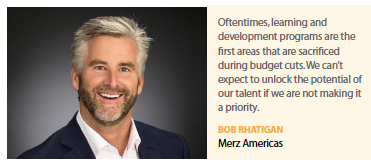 that will experience accelerated growth will be medical equipment and supplies, all forms of dosage and device manufacturing, and most importantly, R&D for emerging biosimilars. Needless to say, an inclusive workforce is needed to ensure success in this highly competitive market."
that will experience accelerated growth will be medical equipment and supplies, all forms of dosage and device manufacturing, and most importantly, R&D for emerging biosimilars. Needless to say, an inclusive workforce is needed to ensure success in this highly competitive market."
Women represent a significant and meaningful percentage of the workforce and bring with them unique perspectives, strength in sound decision-making, equally acquired levels of education, natural traits to drive and deliver success and admirable work ethics that are critical to the success of every organization, Michelle Graham, senior VP, chief human resources officer, Tesaro. She says companies need to create a culture where gender diversity is recognized and welcomed. “This needs to be a concerted effort across the organization, and especially from top leadership — across various functions from selection to onboarding to making promotion decisions and where individual skills and outcomes are rewarded by merit," she says. “At Tesaro, about 54% of our  associate base is made up of women, and they are represented prominently across functions and leadership levels. Gender diversity can give companies a critical edge. Studies have shown that greater gender diversity, especially in corporate settings, can mean increased productivity, innovation, better decision-making, and greater overall employee satisfaction."
associate base is made up of women, and they are represented prominently across functions and leadership levels. Gender diversity can give companies a critical edge. Studies have shown that greater gender diversity, especially in corporate settings, can mean increased productivity, innovation, better decision-making, and greater overall employee satisfaction."
To thrive — from a company and leadership standpoint — in the evolving life-sciences ecosystem, and to achieve the $12 trillion in growth cited by McKinsey, women need to think and act like owners and lead others to do the same, says Andrew Adams, president, Publicis Health Solutions. “A person’s true leadership capacity may not become known until she is pushed beyond her current role," he says. “A common guidance I provide to leaders is to learn how the company makes money and develops its core business’ growth, and then learn how to articulate that to internal and external audiences to show how they impact the bottom line."
Change is Hard, But Necessary
To paraphrase Eldridge Cleaver’s quote: if you aren’t part of the solution, then you are part of the problem. Changing the status quo is certainly not easy and the first step is identifying that change is needed and that by developing and strengthening women leaders, companies can maximize the resources and potential of its organization.
“Although progress is being made, much more needs to be done to develop the next generation of women leaders," says Penny Mitchell, executive VP, healthcare practice lead, Makovsky. “Currently, women account for about 47% of entry-level employees.
However, only one-third of senior managers and one-fifth of C-suite executives are female executives. The divide is even more steep with women of color. They hold 17% of entry-level positions, but just 8% of senior management positions and only 3% of C-suite roles. Of course, different industries have different talent pipelines. Having been in the public relations industry on the agency side specializing in healthcare and pharmaceuticals for the past few decades, I have seen a significant number of women rise to senior-level positions and feel our industry holds more promise than most for this to continue. I have been extremely fortunate to have had wonderful women mentors throughout my career so I encourage the next generation of women leaders to proactively seek mentors."
There are many solutions that companies can employ to develop women leaders and diversity in the workplace and evidence shows that it pays off.
“Unfortunately, too many people still believe that gender diversity is ‘good to have’ but not a priority," Ms. Mitchell says. “Millennials are the largest and most diverse generation, and our workforce is growing more diverse yearly. To remain competitive, companies need to continue to elevate women and instill best practices on inclusion and diversity.
According to a recent TIME article, women who grew up with working mothers were more likely to have careers themselves than those with at-home moms, and they are more likely to have better, higher paying jobs. So not only is it a win for a company to develop women leaders, it is a win for the next generation of female leaders."
At the biotech company ImmunoGen, Audrey Bergan, executive director, human resources, and President and CEO Mark Enyedy, are mindful of the long-held 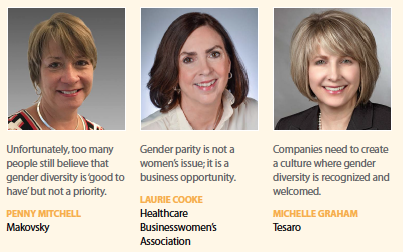 trend of male-dominated C-suites. “Mark and I think about this regularly," she says. “It’s a reality we’re faced with and we’re committed to understanding why it’s a trend and how we could be directly responsible for its perpetuation. For example: if we have an open position, are we just hiring the people we know? Or, are we actively taking the time to understand the marketplace? What does good look like? Who has a track record of success that we can leverage? Who could fill a diversity or gender need for a particular role? Ultimately, we must hire the right person for the right reasons, but we also hold ourselves accountable for actively seeking out diversity at the leadership level at the company."
trend of male-dominated C-suites. “Mark and I think about this regularly," she says. “It’s a reality we’re faced with and we’re committed to understanding why it’s a trend and how we could be directly responsible for its perpetuation. For example: if we have an open position, are we just hiring the people we know? Or, are we actively taking the time to understand the marketplace? What does good look like? Who has a track record of success that we can leverage? Who could fill a diversity or gender need for a particular role? Ultimately, we must hire the right person for the right reasons, but we also hold ourselves accountable for actively seeking out diversity at the leadership level at the company."
At Merz, the philosophy is to reflect the perspectives of the customers it serves. “The vast majority of the people who use our products are women," says Bob Rhatigan, CEO of Merz Americas. “At Merz NA, 40% of our leadership team are women, as are more than half of all managers at the company. We have women leading our finance, communications, compliance, and R&D functions. We recently hired Terri Phillips, M.D., as VP of global medical affairs to build a medical services group. We look for the best talent available and have been very fortunate to be the employer of choice for some truly remarkable women in our industry."
Beth Beghou, founder and managing director at Beghou Consulting, says companies without women in leadership can lack valuable perspectives and skills that can drive innovation. “Over time, this deficiency could compound into a large, cumulative disadvantage," she says. “With women comprising nearly half the workforce nationally and an increasing number of female graduates in life sciences, pharma companies need to do everything they can to attract top female candidates.
“Companies should be aware of any gender bias they may be unintentionally projecting," Ms. Beghou adds. “For example, if a candidate only sees one woman on a company’s website — among dozens of men — she may determine that the company doesn’t prioritize development of women leaders and decide not to even apply."
There are women in the “pipeline" — half of all medical students are women — and Pamela Douglas, M.D., Ursula Geller Professor for Research in Cardiovascular Diseases, Duke Clinical Research Institute, says change will require attention to three areas. First, enhancing leadership skills and mentoring for women and there are currently many opportunities to do this. Second, there needs to be a culture of inclusion at the highest level, more than just education about unintended bias. And third, organizations need to embed systems that are friendly to all talent. “For example, we need to ensure that job descriptions, searches, and performance evaluations eliminate cultural biases," she says.
It is generally recognized that companies need to create a culture where gender diversity is recognized and welcomed. Ms. Graham emphasizes that this mindset needs to be a concerted effort across the organization, and especially from top leadership — across various functions from selection to onboarding to making promotion decisions and where individual skills and outcomes are rewarded by merit. “As an inclusive culture is being truly embraced, simultaneous implementation of programs such as mentoring, sponsorship opportunities, board-readiness preparation, stretch assignments, etc. can be more easily embraced," she says.
Companies must do more than pay lip service to developing women leaders, Ms. Beghou says. “They must proactively open doors for strong female candidates and ensure these opportunities remain open throughout their careers. If companies fail to prioritize the development of women, they will fall behind companies that do value their female employees’ perspectives and contributions."
The effort to develop women leaders should begin as early as the recruitment process. “Companies should aim to invite both men and women to interview candidates," Ms. Beghou recommends. “This helps all prospective employees envision their potential careers through people who have risen through the ranks of the organization."
According to a 2017 study by the Massachusetts Biotechnology Council, nearly half of the 900 women surveyed would turn down an offer from a company with all-male leadership and interview panels. Conversely, Ms. Beghou says, a commitment to providing opportunities for women can encourage them to accept an employment offer. “Companies that invest in women leaders can enjoy  the benefits of attracting top talent of both genders. If companies do this right, the message will speak for itself: There are opportunities for women to grow and excel here. If fair treatment of all genders is written in a company’s DNA, it will naturally reflect in not only the recruitment processes, but also in companywide recognitions, a collaborative and fair work environment, cohesive team dynamics, valued mentorship programs, and of course, promotion cycles."
the benefits of attracting top talent of both genders. If companies do this right, the message will speak for itself: There are opportunities for women to grow and excel here. If fair treatment of all genders is written in a company’s DNA, it will naturally reflect in not only the recruitment processes, but also in companywide recognitions, a collaborative and fair work environment, cohesive team dynamics, valued mentorship programs, and of course, promotion cycles."
As a CEO, Mr. Rhatigan recognizes the importance of hiring talented people who are aligned with the organization’s values and have a personal drive to succeed. “Then, we have to be willing to invest and prioritize development as a strategic priority," he says. “Oftentimes, learning and development programs are the first areas that are sacrificed during budget cuts. We can’t expect to unlock the potential of our talent if we are not making it a priority."
Mr. Adams adds that when the time comes to promote, don’t take no for an answer and think about promoting someone from within the organization. “It is not uncommon for women, in particular, to have second thoughts about taking on more responsibility," he says. “Have the discussion over the course of a couple of conversations."
At many large organizations there are ERGs — employee resource groups — voluntary, employee-led groups that foster a diverse, inclusive workplace aligned with organizational mission, values, goals, business practices, and objectives. These ERGs can help shape organizational culture and provide insights into employee needs and uncover gaps. For smaller organizations such as ImmunoGen that do not have a women’s network in place or an ERG, the key is organically right-sizing female-focused development opportunities. “This focus helps shape our approach as we scale," Ms. Bergan says. “From an individual perspective, executive presence matters. We encourage our leaders to ‘show up’ for the role they want. This telegraphs a combination of qualities that show that the candidate is in charge — or deserves to be."
Ms. Graham counts herself fortunate to be part of Tesaro, where women are represented across all levels of leadership, including the company’s co-founder and president, members of the executive leadership team, as well as mid-level management. “Being part of a company and culture that truly recognizes and rewards talent, regardless of gender, is critical," she says. “Another key element is discovering your leadership voice, and finding the unique edge that sets you apart. All too often women leaders feel the need to emulate what good looks like in order to get ahead. This can have unintended consequences to their long-term trajectory and personal leadership brand. Cultivating an authentic leadership style requires self-reflection, feedback, and tenacity, but this is a critical part of any leader’s journey."
Ms. Cooke advises women to create their personal career spotlight map to identify what they are good at (strengths), what they are passionate about (interests), and what skills/competency areas the company is interested in (needs). “Where these three circles overlap is the bullseye — your secret sauce — that can be used to create your brand identity. Seek out people in your company or tap into an external association that can help you create this map, as it takes self-awareness to accurately develop these insights. Then make your targeted interests known along with how you can help the company. People can’t read minds, so don’t make it hard for other leaders to think about you when opportunities arise. Owning and promoting your brand lets others know what you uniquely bring to the table."(PV)
~~~~~~~~~~~~~~~~~~~~~~~~~
D&I — An Organizational Imperative
Joe DePinto, President, Cardinal Health Specialty Solutions
Diversity of teams at all levels in an organization is a must. The business case is clear — diverse and inclusive teams are higher performing than teams that lack diversity.
Teams that have diversity of thought, race, gender, and experience not only challenge each other to develop better solutions to problems, they’re also better equipped to understand and address the needs of healthcare stakeholders. Research shows that women already make 80% of the healthcare decisions in families. Also, the majority of physicians under the age of 35 are women, and the number of women entering medical school is continuing to grow. Companies that want to influence healthcare decisions in the future are going to need leaders and teams that understand women.
As the healthcare industry becomes more complex and fast-paced, talent development is becoming a bigger priority. In high-performing companies, we are seeing more strategy and structure around the talent development process, as well as more focus on diversity. Rather than only focusing on talent development once or twice a year — at midyear and year-end performance reviews — development discussions are happening throughout the year with clearly defined action plans and regular review of the plans in leadership meetings. Best practices include providing stretch assignments to top talent to enable employees to build diverse skill sets and commitment to moving talent within an organization to enable the individuals to gain broader and more diverse experience. In the future, we will see large organizations focusing more on talent development metrics, so they can be more effective in training, developing, and retaining talent across disciplines and business segments.
Up-and-coming leaders need to understand what their passion is and what they love doing. If you are engaged in activities you are passionate about, the opportunities are limitless. When considering new opportunities, leaders should ask themselves, “Does this next step feed my passion?" and “Does it help me achieve my long-term career goals?" When mentoring young leaders, I often encourage them to take chances and build diverse skill sets. It is okay to be a bit uncomfortable. Depth and breadth of experience is valuable long term. Never take a job just for a title — chasing titles can do more harm than good.



















